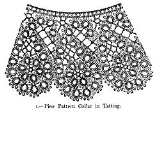
Tatting
Encyclopedia
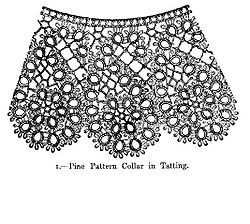
Lace
Lace is an openwork fabric, patterned with open holes in the work, made by machine or by hand. The holes can be formed via removal of threads or cloth from a previously woven fabric, but more often open spaces are created as part of the lace fabric. Lace-making is an ancient craft. True lace was...
constructed by a series of knot
Knot
A knot is a method of fastening or securing linear material such as rope by tying or interweaving. It may consist of a length of one or several segments of rope, string, webbing, twine, strap, or even chain interwoven such that the line can bind to itself or to some other object—the "load"...
s and loops
Loop (knot)
In reference to knots, loop may refer to:* One of the fundamental structures used to tie knots. Specifically, it is a full circle formed by passing the working end over itself.* A type of knot used to create a closed circle in a line....
. Tatting can be used to make lace edging as well as doilies, collar
Collar (clothing)
In clothing, a collar is the part of a shirt, dress, coat or blouse that fastens around or frames the neck. Among clothing construction professionals, a collar is differentiated from other necklines such as revers and lapels, by being made from a separate piece of fabric, rather than a folded or...
s, and other decorative pieces. The lace is formed by a pattern of rings and chains formed from a series of cow hitch
Cow hitch
The cow hitch is a hitch knot used to attach a rope to an object. The cow hitch comprises a pair of half-hitches tied in opposing directions, as compared to the clove hitch in which the half-hitches are tied in the same direction. It has several variations and is known under a variety of names...
, or half-hitch knots, called double stitches (ds), over a core thread
Yarn
Yarn is a long continuous length of interlocked fibres, suitable for use in the production of textiles, sewing, crocheting, knitting, weaving, embroidery and ropemaking. Thread is a type of yarn intended for sewing by hand or machine. Modern manufactured sewing threads may be finished with wax or...
. Gaps can be left between the stitches to form picot
Picot
A picot is a loop of thread created for functional or ornamental purposes along the edge of lace, ribbon, crocheted, knitted or tatted material. These loops vary in size, according to their intended function and to their creator's artistic intention....
s, which are used for practical construction as well as decorative effect.
Tatting dates to the early 19th century. The term for tatting in most European languages is derived from French frivolité, which refers to the purely decorative nature of the textiles produced by this technique. The technique was developed to imitate point lace.
Shuttle tatting
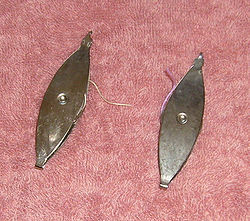
Yarn
Yarn is a long continuous length of interlocked fibres, suitable for use in the production of textiles, sewing, crocheting, knitting, weaving, embroidery and ropemaking. Thread is a type of yarn intended for sewing by hand or machine. Modern manufactured sewing threads may be finished with wax or...
and guiding it through loops to make the requisite knots. It is normally a metal or ivory pointed oval shape less than 3 inches (76.2 mm) long, but shuttles come in a variety of shapes and materials. Shuttles often have a point or hook on one end to aid in the construction of the lace. Antique shuttles and unique shuttles have become highly sought after by collectors — even those who do not tat.
To make the lace, the tatter wraps the thread around one hand and manipulates the shuttle with the other hand. No tools other than the thread, the hands, and the shuttle are used, though a crochet
Crochet
Crochet is a process of creating fabric from yarn, thread, or other material strands using a crochet hook. The word is derived from the French word "crochet", meaning hook. Hooks can be made of materials such as metals, woods or plastic and are commercially manufactured as well as produced by...
hook may be necessary if the shuttle does not have a point or hook.
Needle tatting
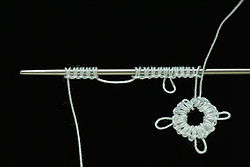
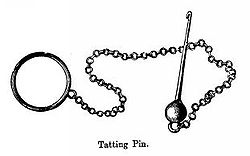
Needle tatting originated in the early twentieth century, but did not become popular until much later. A tatting needle is a long, blunt needle that does not change thickness at the eye of the needle. The needle used must match the thickness of the thread chosen for the project. Rather than winding the shuttle, the needle is threaded with a length of thread. To work with a second color, a second needle is used.Although needle tatting looks similar to shuttle tatting, it differs in structure and is slightly thicker and looser because both the needle and the thread must pass through the stitches.
In the late twentieth century, tatting needles became commercially available in a variety of sizes, from fingering yarn down to size 80 tatting thread. Patterns are written specifically for needle tatting, although shuttle tatting patterns may be used without modification. There are currently two manufacturers of tatting needles.
Cro-tatting
Cro-tatting combines needle tatting with crochet. The cro-tatting tool is a tatting needle with a crochet hook at the end. One can also cro-tat with a bullion crochet hook or a very straight crochet hook. In the nineteenth century, "crochet tatting" patterns were published which simply called for a crochet hook. One of the earliest patterns is for a crocheted afghan with tatted rings forming a raised design. Patterns are available in English and are equally divided between yarn and thread. In its most basic form the rings are tatted with a length of plain thread between them, as in single shuttle tatting. In modern patterns, beginning in the early twentieth century, the rings are tatted and the arches or chains are crocheted. Many people consider cro-tatting more difficult than crochet or needle tatting. Some tatting instructors recommend using a tatting needle and a crochet hook to work cro-tatting patterns. Cro-tatting is most popular in Japan.NOTE: The stitches of cro-tatting (and needle tatting before you close a ring) unravel easily, unlike tatting that is made with a shuttle.
Materials
Older designs, especially through the early 1900s, tend to use fine white or ivory thread (50 to 100 widths to the inch) and intricate designs. This thread was either made of silk or a silk blend, to allow for improper stitches to be easily removed. Newer designs from the 1920s and onward often use thicker thread in one or more colors. The best thread for tatting is a "hard" thread that does not untwist readily. DMC Cordonnet thread is a common tatting thread; Perl cotton is an example of a beautiful cord that is nonetheless a bit loose for tatting purposes. Some tatting designs incorporate ribbonRibbon
A ribbon or riband is a thin band of material, typically cloth but also plastic or sometimes metal, used primarily for binding and tying. Cloth ribbons, most commonly silk, are often used in connection with clothing, but are also applied for innumerable useful, ornamental and symbolic purposes...
s and bead
Bead
A bead is a small, decorative object that is usually pierced for threading or stringing. Beads range in size from under to over in diameter. A pair of beads made from Nassarius sea snail shells, approximately 100,000 years old, are thought to be the earliest known examples of jewellery. Beadwork...
s.
Patterns
Older patterns use a long hand notation to describe the stitches needed while newer patterns tend to make extensive use of abbreviations and an almost mathematical looking notation. The following examples describe the same small piece of tatting (the first Ring in the Hen and Chicks pattern)- Ring five ds, three picots separated by five ds, five ds, close, turn, space
- R 5ds, 3 p sep by 5ds, 5ds, cl, turn, sp
- R 5-5-5-5 cl rw sp
Some tatters prefer a visual pattern where the design is drawn schematically with annotations indicating the number of ds and order of construction. This can either be used on its own or alongside a written pattern.
History
Some believe that tatting may have developed from nettingNet (textile)
Net or netting is any textile in which the warp and weft yarns are looped or knotted at their intersections, resulting in a fabric with large open spaces between the yarns....
and decorative ropework as sailor
Sailor
A sailor, mariner, or seaman is a person who navigates water-borne vessels or assists in their operation, maintenance, or service. The term can apply to professional mariners, military personnel, and recreational sailors as well as a plethora of other uses...
s and fishers
Fishing
Fishing is the activity of trying to catch wild fish. Fish are normally caught in the wild. Techniques for catching fish include hand gathering, spearing, netting, angling and trapping....
would put together motifs for girlfriends and wives at home. Decorative ropework employed on ships includes techniques (esp. coxcombing
Coxcombing
Coxcombing is a decorative knotwork performed by sailors. The general purpose to dress-up items and parts of ships and boats during the age of sail.Modern uses are to wrap boat tillers and ships' wheels with small diameter line to enhance the grip as well as the nautical appeal.Knots used in...
) that show striking similarity with tatting. A good description of this can be found in Knots, Splices and Fancywork.
Some believe tatting originated over 200 years ago, often citing shuttles seen in eighteenth century paintings of women such as Charlotte of Mecklenburg-Strelitz
Charlotte of Mecklenburg-Strelitz
Charlotte of Mecklenburg-Strelitz was the Queen consort of the United Kingdom as the wife of King George III...
, Madame Adelaide (daughter of Louis XV of France
Louis XV of France
Louis XV was a Bourbon monarch who ruled as King of France and of Navarre from 1 September 1715 until his death. He succeeded his great-grandfather at the age of five, his first cousin Philippe II, Duke of Orléans, served as Regent of the kingdom until Louis's majority in 1723...
), and Anne, Countess of Albemarle. A close inspection of those paintings shows that the shuttles in question are too large to be tatting shuttles, and that they are actually knotting shuttles. There is no documentation, nor any examples of tatted lace, that date prior to 1800. All of the available evidence shows that tatting originated in the early 19th century.
As most fashion magazines, and home economics magazines from the first half of the 20th century attest, tatting had a substantial following. When fashion included feminine touches such as lace collars and cuffs, and inexpensive yet nice baby shower gifts were needed, this creative art flourished. As the fashion moved to a more modern look and technology made lace an easy and inexpensive commodity to purchase, hand-made lace began to decline.
Tatting has been used in occupational therapy to keep convalescent patients' hands and minds active during recovery, as documented, for example, in Betty MacDonald
Betty MacDonald
Betty MacDonald was an American author who specialized in humorous autobiographical tales, and is best known for her book The Egg and I. She also wrote the Mrs. Piggle-Wiggle series of children's books...
's The Plague & I.
External links
- Tatting Demo Video 1 Demo Video 2 Demo Video 3
- InTatters Online Tatting resource and discussion site.
- The Tatting Forums An Online Tatting Community.
- Czech tatting fan Czech fan site about tatting in English language.

